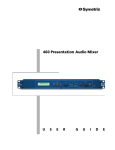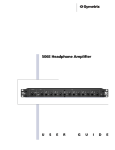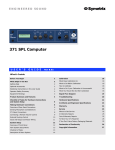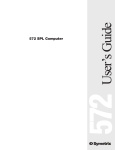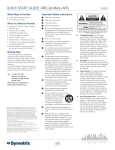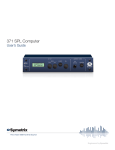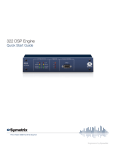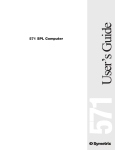Download 372 SPL Computer
Transcript
372 SPL Computer U S E R N G U I D E 372 SPL Computer User’s Guide © January 2001 Symetrix, Inc. All rights reserved. Printed in the United States of America Symetrix Part Number 53372-0C00 The information in this guide is subject to change without notice. Symetrix, Inc. shall not be liable for technical or editorial errors or omissions contained herein; nor is it liable for incidental or consequential damages resulting from the furnishing, performance, or use of this material. Mention of third-party products is for informational purposes only and constitutes neither an endorsement nor a recommendation. Symetrix assumes no responsibility with regard to the performance or use of these products. Under copyright laws, no part of this user guide may be reproduced or transmitted in any form or by any means, electronic or mechanical, without permission in writing from Symetrix, Inc. If, however, your only means of access is electronic, permission to print one copy is hereby granted. Permission to copy the Architects and Engineers Specificiations for written proposals specifying equipment for sound reinforcement systems is, also, granted. Symetrix, Inc. 6408 216th St. SW Mountlake Terrace WA 98043 USA Tel: 425.778.7728 Fax: 425.778.7727 Web: www.symetrixaudio.com Email: [email protected] Symetrix 372 SPL Computer User’s Guide Contents Before You Begin 2 Gap Threshold 20 What Ships in the Box 2 Force Sense Time 20 Getting Help 2 AGC 20 Optional Rackmount Accessories 2 Trigger Input 21 Notational Conventions in this User Guide 2 Setup Unlocked 21 Operational Safety Summary 3 Equipment Markings 3 Calibrating the 372 22 Features of the 372 4 Conditions Under Which the 372 Will Not Sense 23 Checklist of Tasks for Hardware Connections, System Setup, and Calibration 5 Signal Flow Diagram 24 Making Hardware Connections 6 Input and Output Connector Wiring 25 Overview of Rear Panel Connectors and Connections 6 Troubleshooting 26 Sensing Speaker Considerations 8 372 Basic Connection 9 Hardware Specifications 28 Architects and Engineers Specifications 29 Connecting an External Relay to Drive Amplifiers Larger than 200W 10 Connecting Up to 20 Slaves 11 Connecting an External Relay to Attach Slaves 12 Warranty 30 Connecting a Push Button Switch to Force or Prevent Sensing 13 Service 31 System Setup 14 Declaration of Conformity 32 Overview of Front Panel 14 How System Setup Works 15 Description of Menu Features 16 Operating Mode 16 Status 18 History 18 Listen 18 Set MIN Limit 19 Set MAX Limit 19 Averaging Time 19 Gain: Sense Ratio 19 1 Symetrix 372 SPL Computer User’s Guide Before You Begin | What Ships in the Box | Getting Help | Optional Rackmount Accessories | Notational Conventions in this User Guide | Operator Safety Summary | Equipment Markings What Ships in the Box Getting Help The 372 unit If you have questions beyond the scope of this guide, contact our Customer Service Department in the following ways: One PS-3 or PS-3E (export version) power supply T US customers (425) 778-7728 International customers (425) 778-7728 8:00 am to 4:30 pm Monday through Friday, Pacific Time F (425) 778-7727 This user’s guide [email protected] www.symetrixaudio.com Optional Rackmount Accessories MODEL ITEM DESCRIPTION RM-3 19" Rackmount Tray 1U shelf FP-3 Filler Panel Covers unused half of rack tray when one 372 unit is mounted PY-3 Y Power Cable Connects a 372 with any other 300 Series product Contact your dealer or Symetrix for purchasing information. Notational Conventions in this User Guide Note Identifies information that needs extra emphasis. Generally supplies extra information to help you to better use the 372. CAUTION Identifies information that, if ignored, may cause damage to the 372 or other equipment in your system. WARNING Identifies information that, if ignored, may be hazardous to your health or that of others. SMALL CAPS Controls, switches or other markings on the chassis of the 372. Bold Face Indicates menu option in the 372 LCD display. 2 Symetrix 372 SPL Computer User’s Guide Before You Begin | What Ships in the Box | Getting Help | Optional Rackmount Accessories | Notational Conventions in this User Guide | Operator Safety Summary | Equipment Markings Operator Safety Summary Follow all warnings and instructions. Install in accordance with the manufacturer’s instructions. Power Source This product is intended to operate from a Symetrix PS-3 or PS-3E power supply. Grounding The chassis of this product is grounded through the grounding conductor of the PS-3 or PS-3E power cord. To avoid electric shock, plug the power cord into a properly wired receptacle before making any connections to the product. A protective ground connection, by way of the grounding conductor in the power cord, is essential for safe operation. Do not defeat the safety purpose of the grounding plug. The grounding plug has two blades and a third grounding prong. The third prong is provided for your safety. When the provided plug does not fit your outlet, consult an electrician for replacement of the obsolete outlet. Danger from Loss of Ground If the protective ground connection is lost, all accessible conductive parts, including knobs and controls that may appear to be insulated, can render an electric shock. Proper Power Cord Use only the power cord and connector specified for the product and your operating locale. Use only a cord that is in good condition. Protect the power cord from being walked on or pinched, particularly at the plug, convenience receptacle, and the point where the cord exits from the apparatus. Equipment Markings Operating Location Do not operate this equipment under any of the following conditions: explosive atmospheres, in wet locations, in inclement weather, improper or unknown AC mains voltage, or if improperly fused. Do not install near any heat source such as radiators, heat registers, stoves, or other apparatus (including amplifiers) that produce heat. Unplug this apparatus during lightning storms or when unused for long periods of time. Stay Out of the Box To avoid personal injury (or worse), do not remove the product covers or panels. Do not operate the product without the covers and panels properly installed. Only use accessories specified by the manufacturer. Clean only with a damp cloth. User-serviceable parts There are no user serviceable parts inside the 372. In case of failure, refer all servicing to the factory. Servicing is required when the 372 has been damaged in any way, such as when a power supply cord or plug is damaged, liquid has been spilled or objects have fallen into the apparatus, the apparatus has been exposed to rain or moisture, does not operate normally, or has been dropped. CAUTION RISK OF ELECTRIC SHOCK DO NOT OPEN TO REDUCE THE RISK OF FIRE OR SHOCK DO NOT EXPOSE WARNING: ELECTRIC THIS EQUIPMENT TO RAIN OR MOISTURE DE CHOC ELECTRIQUE AVIS: RISQUE NE PAS OUVRIR SEE OWNERS MANUAL. VOIR CAHIER D’INSTRUCTIONS. No user serviceable parts inside. Refer servicing to qualified service personnel. Il ne se trouve a l’interieur aucune piece pourvant entre reparée l’usager. S’adresser a un reparateur compétent. The lightning flash with arrowhead symbol within an equilateral triangle is intended to alert the user of the presence of uninsulated “dangerous voltage” within the product’s enclosure that may be of sufficient magnitude to constitute a risk of electric shock to persons. The exclamation point within an equilateral triangle is intended to alert the user of the presence of important operating and maintenance (servicing) instructions in the literature accompanying the product (i.e., this user’s guide). CAUTION To prevent electric shock, do not use the polarized plug supplied with the unit with any extension cord, receptacle, or other outlet unless the blades can be fully inserted. 3 Symetrix 372 SPL Computer User’s Guide Features of the 372 Uses Speakers for Noise Sensing In less than 1 second, the Symetrix 372 temporarily opens up the amplifier connection and routes the loudspeakers to a preamplifier for the purpose of measuring changes in the ambient noise level. Samples during absence of page and/or music audio, or at preset intervals. Headphone Monitoring Monitor the sense signal using a separate front panel headphone output. 5 Operating Modes MUSIC Music only or music + page. Use Gap and/or Force Sense Time. PAGE Only paging and annoucement audio. Use Force Sense Time at preset intervals. SLAVE Forces all 372 units in a multi-zone system to execute a sense sample at the same time. HISTORY Records and displays the lowest and highest SPL readings from when the unit was last reset. BYPASS Bypasses the gain control of the SPL controller and the AGC. Signal Path Controls mono or stereo signals through Euroblock connectors. Programmable Sensing Operation Select the auto-sense mode and/or the time interval between sense samples. Simple Calibration Use step-through menus on the front panel LCD. Perform calibration under typical installation conditions. No waiting for the quietest or noisiest ambient environment. AGC Control Enables or disables auto leveling of input signals. Ambient Adjustment Choose an adjustment ratio of SPL change vs. program level change. Sense Signal Monitoring Display numeric reading and relative bargraph of the signal appearing at the sense terminals. Listen to sense signal with headphones connected to front panel mono output. Gain Controls Set minimum and maximum limits for SPL gain range. Gain range is +20 to –30 db. Averaging Time Choose integration time of the running average SPL. 4 Symetrix 372 SPL Computer User’s Guide Checklist of Tasks for Hardware Connections, System Setup, and Calibration REQUIRED HARDWARE CONNECTIONS SYSTEM SETUP RECOMMENDED TASK TO DO Connecting input sources Connecting output sources (use Symetrix 303 for unbalanced outputs) Connecting speaker for sensing and music/paging Connecting speaker for either music or paging; does not sense Connecting an external relay if maximum amplifier voltage and wattage exceeded Connecting slave 372s Connecting a switch or contact closure to manually force or prevent sensing Choose Operating Mode* View calibration Status Collect History of highest and lowest SPLs Set gain level in Listen Set MIN limit (gain) Set MAX limit (gain) Specify number of samples in Averaging Time Specify Gain: Sense Ratio Set Gap Threshold Specify time for Force Sense Time CALIBRATION OPTIONAL Enable AGC Specify type of Trigger Input Lock or Unlock Setup Equating ambient noise level to 0 db (Unity) gain *Bold face indicates menu name in LCD display 5 Symetrix 372 SPL Computer User’s Guide Making Hardware Connections | Overview of Rear Panel Connectors and Connections | Sensing Speaker Considerations | 372 Basic Connection | Connecting an External Relay to Drive Amplifiers Larger than 200W | Connecting Up to 20 Slaves | Connecting an External Relay to Attach Slaves | Connecting a Push Button Switch to Force or Prevent Sensing FROM AMP TO SPEAKER SENSE POWER INPUT LINE OUTPUT RIGHT LEFT LINE INPUT RIGHT LEFT 372 TRIGGER EXT. RELAY CONNECT TO SYMETRIX PS-3 OR PS-3E POWER SUPPLY ONLY Overview of Rear Panel Connectors and Connections CONNECTION CONNECTOR TYPE WHAT IT DOES Power Input 7-pin DIN connector Accepts power only from Symetrix PS-3 or PS-3E power supply. FROM AMP 2 terminal barrier strip Accepts signal from power amplifier. This output may be grounded or bridged. 8A maximum current rating. If your speaker load exceeds the following ratings, you will need to use an external relay (See Connecting an External Relay to Attach Slaves). MAX AMPLIFIER OUTPUT RATINGS 16 ohms 400W 70V 300W 8 ohms 200W 4 ohms 100W TO SPEAKER SENSE 2 terminal barrier strip Delivers signal to loudspeaker system. Do not ground either of these terminals. EXT RELAY Euroblock terminals Open-collector drive signal for external sense relay. Can power amplifiers larger than 200W at 8 ohms (See Connecting an External Relay to Attach Slaves). Controls as many as 20 slave 372 units directly from the EXT RELAY output of the master 372. This output can also drive the TRIGGER input. GROUND Euroblock terminals Ground return for external relay and trigger. TRIGGER Euroblock terminals Active low input forces sense event. Can force or prevent a sense event manually (See Connecting a Push Button Switch to Force or Prevent Sensing). Is internally pulled to the 5V supply by way of a 20k ohm resistor. From this connection attach slave 372 units to the master 372. 6 Symetrix 372 SPL Computer User’s Guide Making Hardware Connections | Overview of Rear Panel Connectors and Connections | Sensing Speaker Considerations | 372 Basic Connection | Connecting an External Relay to Drive Amplifiers Larger than 200W | Connecting Up to 20 Slaves | Connecting an External Relay to Attach Slaves | Connecting a Push Button Switch to Force or Prevent Sensing CONNECTION CONNECTOR TYPE WHAT IT DOES LINE OUTPUT Euroblock terminals These connectors deliver a differential balanced output at 200 ohm source impedance. For unbalanced use, use the positive line output terminals and the ground terminals. Ignore (float) the minus output terminals. The output stage is a pair of opamps, with the plus and minus output terminals at 180° antiphase with each other. It emulates a grounded centertap transformer. The series build-out resistors are 100 ohms in each leg. For wiring diagram, see the section Input and Output Connector Wiring. LINE INPUT Euroblock terminals Balanced input for the 372. 20k ohm balanced bridging. For unbalanced sources, connect the minus input terminal to the source ground at the source. Note Feeding unbalanced inputs directly from balanced outputs is not recommended due to the possibility of ground loops. You may want to use the Symetrix 303 isolation transformer to break the ground connection and eliminate the ground loop. With unbalanced sources, it is preferable to carry the low side of the input all the way back to the ground connection of the source. For wiring diagram, see the section Input and Output Connector Wiring. 7 Symetrix 372 SPL Computer User’s Guide Making Hardware Connections | Overview of Rear Panel Connectors and Connections | Sensing Speaker Considerations | 372 Basic Connection | Connecting an External Relay to Drive Amplifiers Larger than 200W | Connecting Up to 20 Slaves | Connecting an External Relay to Attach Slaves | Connecting a Push Button Switch to Force or Prevent Sensing Sensing Speaker Considerations Speaker Location 70V Systems 4, 8, and 16 Ohm Systems If a sensing speaker is located near a localized noise source that is not typical for the ambient noise level of the controlled zone, the 372 determines that the zone is noiser than it really is. For example, the noise from a large machine of some sort, or maybe a kids play area, or a video game. The solution is to have the speakers that are near the noise source driven directly from the amplifier so that they are not used for sensing. In a 70V system, the signal level returned by the speakers when the 372 is sensing is higher, because of the step-up action of the line transformers. With highly-efficient speakers, this may present the problem of overloading the sense input of the 372. Use the Listen mode to check the level of the signal while the 372 senses. You may need to lower the gain position of the AMBIENT SENSE GAIN switch. More information about the gain setting is found in Listen under the section System Setup. In these speaker impedance systems, the signal levels returned to the 372 are low. Use the Listen mode to check the level of the signal while the 372 senses. You may need to select the high gain position of the AMBIENT SENSE GAIN switch. A common practice in 70V systems is to provide autotransformers or L-pads after the line transformer to allow local volume control. These controls should not be used with the 372. Allowing any sort of signal level control after the 372 invalidates your calibration settings. If you must provide a local control, then ensure that the controlled zone is a minor part of the entire system. In this controlled zone, volume level will not be ideal and sensing should not be used. Also, it is imperative that every speaker and transformer in the system operate in-phase. 8 Symetrix 372 SPL Computer User’s Guide Making Hardware Connections | Overview of Rear Panel Connectors and Connections | Sensing Speaker Considerations | 372 Basic Connection | Connecting an External Relay to Drive Amplifiers Larger than 200W | Connecting Up to 20 Slaves | Connecting an External Relay to Attach Slaves | Connecting a Push Button Switch to Force or Prevent Sensing 372 Basic Connection Signal I/O Connections These connectors are designed for use with bare wire. Do not tin strand wires before inserting them into the connectors. Connect all speakers used for sensing and either music or paging to this output. If using unbalanced connections, see wiring diagram in the section Input and Output Connector Wiring. 1 Connect your line-level source to the rear-panel input connectors. The relay contacts handle 8A continuous current. 3 FROM AMP SENSE TRIGGER EXT. RELAY POWER INPUT LINE INPUT RIGHT LEFT 3 2 1 Connect the outputs as required. These connectors deliver a differential balanced output signal. For unbalanced use, use the positive line output terminals and the ground terminals. Ignore (float) the minus output terminals. Input Source Amplifier Connect all speakers that do not sense to the amplifier output. Amplifier and Speaker Connections 3 LINE OUTPUT RIGHT LEFT CONNECT TO SYMETRIX PS-3 OR PS-3E POWER SUPPLY ONLY These connectors may be driven from a balanced or unbalanced source. When using an unbalanced source, connect the output minus terminal to ground either at the source or at the 372. 2 TO SPEAKER 372 Note Feeding unbalanced inputs directly from balanced outputs is not recommended due to the possibility of ground loops. An option is to use the Symetrix 303 isolation transformer to break the ground connection and eliminate the ground loop. These speakers are required. Connect your amplifier and speakers to the barrier strip connectors. Use these speakers for only music or paging. These speakers are optional. The speaker and amplifier connections are earth-free (floating). The 372 treats the speaker connections after its sensing relay as if they were a balanced line. Do not ground either side of the speaker line. It is OK if the one side of the amplifier output is grounded. 9 Symetrix 372 SPL Computer User’s Guide Making Hardware Connections | Overview of Rear Panel Connectors and Connections | Sensing Speaker Considerations | 372 Basic Connection | Connecting an External Relay to Drive Amplifiers Larger than 200W | Connecting Up to 20 Slaves | Connecting an External Relay to Attach Slaves | Connecting a Push Button Switch to Force or Prevent Sensing Connecting an External Relay to Drive Amplifiers Larger than 200W When controlling amplifiers larger than 200W, you must use an external DPDT relay. The internal relay of the 372 cannot handle more than 8A of load current. External DC Coil Relay Low (–) Low (–) High (+) High (+) RECOMMENDED MAXIMUM AMPLIFIER WATTAGES 300W 70V 200W 8 ohms 100W 4 ohms You must supply power for the relay and the relay must have a backbiased 1N4002 diode connected across its coil to absorb the back EMF from the relay coil. The transistor has a 60V VCE rating (MPSA 06). DC Power Supply (–) 16 ohms (+) 400W Amplifier 1N4002 or Equivalent Diode FROM AMP POWER INPUT TO SPEAKER CONNECT TO SYMETRIX PS-3 OR PS-3E POWER SUPPLY ONLY The 24V version of the Potter & Brumfield PRD11DGO works well. Its DPDT contacts are rated at 30A. 10 SENSE TRIGGER EXT. RELAY LINE OUTPUT RIGHT LEFT LINE INPUT RIGHT LEFT Symetrix 372 SPL Computer User’s Guide Making Hardware Connections | Overview of Rear Panel Connectors and Connections | Sensing Speaker Considerations | 372 Basic Connection | Connecting an External Relay to Drive Amplifiers Larger than 200W | Connecting Up to 20 Slaves | Connecting an External Relay to Attach Slaves | Connecting a Push Button Switch to Force or Prevent Sensing Connecting Up to 20 Slaves Master 372 A master 372 can direct any number of slave 372 units to take an ambient sample. You can parallel slave 372 units directly together from the master unit to enable you to sense at the same time in adjacent or multiple installation zones. If the slave 372 units are in remote locations, use an external relay to connect the slaves to the master unit (see Connecting an External Relay to Attach Slaves). TO SPEAKER FROM AMP As many as 20 slave 372 units may be controlled directly from the master 372. LINE OUTPUT RIGHT LEFT LINE INPUT RIGHT LEFT CONNECT TO SYMETRIX PS-3 OR PS-3E POWER SUPPLY ONLY 372 POWER INPUT SENSE TRIGGER EXT. RELAY Slave 372 MAXIMUM CABLE LENGTH FROM AMP POWER INPUT TO SPEAKER SENSE TRIGGER EXT. RELAY LINE OUTPUT RIGHT LEFT LINE INPUT RIGHT LEFT CONNECT TO SYMETRIX PS-3 OR PS-3E POWER SUPPLY ONLY 372 IMPORTANT! As of 372 hardware revision C, an internal jumper (J8) has been added which must be in correctly configured on the master 372 in order to properly drive the slaves. Moving J8 to connect pins 2 and 3 configures the TRIGGER input connection on the Master 372 to become a Slave Drive OUTPUT. This reconfiguration is necessary to prevent a "false sensing" problem when multiple zones bleed into each other. This new way of configuring the master 372 ensures that all 372's will sense in sync thus avoiding false sense readings from zone bleed. From the front panel of the slave 372 LCD menu display: POWER INPUT CONNECT TO SYMETRIX PS-3 OR PS-3E POWER SUPPLY ONLY POWER INPUT CONNECT TO SYMETRIX PS-3 OR PS-3E POWER SUPPLY ONLY POWER INPUT CONNECT TO SYMETRIX PS-3 OR PS-3E POWER SUPPLY ONLY POWER INPUT CONNECT TO SYMETRIX PS-3 OR PS-3E POWER SUPPLY ONLY Press NEXT to gain access to Operating Mode. Rotate ADJUST to select Slave mode. FROM AMP TO SPEAKER FROM AMP TO SPEAKER FROM AMP TO SPEAKER FROM AMP TO SPEAKER FROM AMP TO SPEAKER SENSE LINE OUTPUT RIGHT LEFT LINE INPUT RIGHT LEFT SENSE LINE OUTPUT RIGHT LEFT LINE INPUT RIGHT LEFT SENSE LINE OUTPUT RIGHT LEFT LINE INPUT RIGHT LEFT SENSE LINE OUTPUT RIGHT LEFT LINE INPUT RIGHT LEFT SENSE LINE OUTPUT RIGHT LEFT LINE INPUT RIGHT LEFT TRIGGER EXT. RELAY 372 CONNECT TO SYMETRIX PS-3 OR PS-3E POWER SUPPLY ONLY TRIGGER EXT. RELAY 372 Connect the other end of the cable to the TRIGGER input and Ground terminals of each slave unit in parallel. POWER INPUT TRIGGER EXT. RELAY 372 Connect a cable from TRIGGER and Ground terminals of the master unit. TRIGGER EXT. RELAY 372 On the master 372, remove the top and move the jumper (J8) to connect pins 2 and 3. (Pins 1 and 2 are connected at the factory. This is the default position and this jumper should only be changed on the master 372. J8 should remain in the factory default position on all slaves). Slave Group up to 20 units Press NEXT to locate Trigger Input. Check to see that Force Sense is selected. (Force Sense is the default setting.) (See Operating Mode—Slave in the section System Setup for additional information) 11 TRIGGER EXT. RELAY 372 Depends upon the difference in ground potential (if any) between the individual units. Symetrix 372 SPL Computer User’s Guide Making Hardware Connections | Overview of Rear Panel Connectors and Connections | Sensing Speaker Considerations | 372 Basic Connection | Connecting an External Relay to Drive Amplifiers Larger than 200W | Connecting Up to 20 Slaves | Connecting an External Relay to Attach Slaves | Connecting a Push Button Switch to Force or Prevent Sensing Connecting an External Relay to Attach Slaves Master 372 Use an External Relay: To connect more than 20 slave 372 units together from the master unit to sense at the same time in adjacent or multiple installation zones. FROM AMP POWER INPUT TO SPEAKER SENSE TRIGGER EXT. RELAY LINE OUTPUT RIGHT LEFT LINE INPUT RIGHT LEFT 372 CONNECT TO SYMETRIX PS-3 OR PS-3E POWER SUPPLY ONLY —or— To connect slave 372 units in remote locations from the master unit. External Relay Pack If some of the slave units are a long distance away from the master, a direct connection might give rise to ground loop problems. To avoid this, use an external relay to isolate the connection between the master and the distant slaves. Sen FROM AMP SENSE TRIGGER EXT. RELAY LINE OUTPUT RIGHT LEFT Sen LINE INPUT RIGHT LEFT CONNECT TO SYMETRIX PS-3 OR PS-3E POWER SUPPLY ONLY POWER INPUT CONNECT TO SYMETRIX PS-3 OR PS-3E POWER SUPPLY ONLY POWER INPUT CONNECT TO SYMETRIX PS-3 OR PS-3E POWER SUPPLY ONLY POWER INPUT CONNECT TO SYMETRIX PS-3 OR PS-3E POWER SUPPLY ONLY POWER INPUT CONNECT TO SYMETRIX PS-3 OR PS-3E POWER SUPPLY ONLY POWER INPUT CONNECT TO SYMETRIX PS-3 OR PS-3E POWER SUPPLY ONLY LINE OUTPUT RIGHT LEFT LINE INPUT RIGHT LEFT TO SPEAKER SENSE TRIGGER EXT. RELAY LINE OUTPUT RIGHT LEFT TO SPEAKER SENSE TRIGGER EXT. RELAY LINE OUTPUT RIGHT LEFT TO SPEAKER SENSE TRIGGER EXT. RELAY LINE OUTPUT RIGHT LEFT TO SPEAKER SENSE TRIGGER EXT. RELAY LINE OUTPUT RIGHT LEFT POWER INPUT CONNECT TO SYMETRIX PS-3 OR PS-3E POWER SUPPLY ONLY POWER INPUT CONNECT TO SYMETRIX PS-3 OR PS-3E POWER SUPPLY ONLY POWER INPUT CONNECT TO SYMETRIX PS-3 OR PS-3E POWER SUPPLY ONLY POWER INPUT CONNECT TO SYMETRIX PS-3 OR PS-3E POWER SUPPLY ONLY POWER INPUT CONNECT TO SYMETRIX PS-3 OR PS-3E POWER SUPPLY ONLY LINE INPUT RIGHT LEFT 372 FROM AMP CONNECT TO SYMETRIX PS-3 OR PS-3E POWER SUPPLY ONLY LINE INPUT RIGHT LEFT 372 FROM AMP POWER INPUT LINE INPUT RIGHT LEFT 372 FROM AMP CONNECT TO SYMETRIX PS-3 OR PS-3E POWER SUPPLY ONLY LINE INPUT RIGHT LEFT 372 FROM AMP POWER INPUT FROM AMP TO SPEAKER FROM AMP TO SPEAKER FROM AMP TO SPEAKER FROM AMP TO SPEAKER FROM AMP TO SPEAKER FROM AMP TO SPEAKER FROM AMP TO SPEAKER SENSE LINE OUTPUT RIGHT LEFT LINE INPUT RIGHT LEFT SENSE LINE OUTPUT RIGHT LEFT LINE INPUT RIGHT LEFT SENSE LINE OUTPUT RIGHT LEFT LINE INPUT RIGHT LEFT SENSE LINE OUTPUT RIGHT LEFT LINE INPUT RIGHT LEFT SENSE LINE OUTPUT RIGHT LEFT LINE INPUT RIGHT LEFT SENSE LINE OUTPUT RIGHT LEFT LINE INPUT RIGHT LEFT SENSE LINE OUTPUT RIGHT LEFT LINE INPUT RIGHT LEFT TRIGGER EXT. RELAY 372 CONNECT TO SYMETRIX PS-3 OR PS-3E POWER SUPPLY ONLY SENSE TRIGGER EXT. RELAY TRIGGER EXT. RELAY 372 POWER INPUT TO SPEAKER TRIGGER EXT. RELAY 372 CONNECT TO SYMETRIX PS-3 OR PS-3E POWER SUPPLY ONLY 372 FROM AMP POWER INPUT Slave Group 2 Press NEXT to gain access to Operating Mode. Rotate ADJUST to select Slave mode. 4 Sen TRIGGER EXT. RELAY 372 POWER INPUT TO SPEAKER Connect cables from the external relay outputs to the TRIGGER and Ground terminals of each slave unit in parallel. From the front panel of the slave 372 LCD menu display: 3 Sen Slave 372 Slave Group 1 Connect a cable from TRIGGER and Ground terminals of the master unit to the External Relay control and Ground terminals on the rear panel of the external relay. 2 TRIGGER EXT. RELAY 372 Please see notes on previous page regarding internal jumper configuration of the master 372. Slaved Groups 1 372 IMPORTANT! Ext Relay Control Press NEXT to locate Trigger Input. SENSE LINE OUTPUT RIGHT LEFT LINE INPUT RIGHT LEFT 372 TRIGGER EXT. RELAY FROM AMP TO SPEAKER SENSE TRIGGER EXT. RELAY LINE OUTPUT RIGHT LEFT LINE INPUT RIGHT LEFT 12 TRIGGER EXT. RELAY 372 TO SPEAKER TRIGGER EXT. RELAY 372 (See Description of Menu Features, Operating Mode—Slave in the section System Setup for additional information) FROM AMP 372 Check to see that Force Sense is selected. (Force Sense is the default setting.) Symetrix 372 SPL Computer User’s Guide Making Hardware Connections | Overview of Rear Panel Connectors and Connections | Sensing Speaker Considerations | 372 Basic Connection | Connecting an External Relay to Drive Amplifiers Larger than 200W | Connecting Up to 20 Slaves | Connecting an External Relay to Attach Slaves | Connecting a Push Button Switch to Force or Prevent Sensing Connecting a Push Button Switch to Force or Prevent Sensing You can manually prevent sensing or manually control sensing by using a push button switch. FROM AMP TO SPEAKER SENSE TRIGGER EXT. RELAY POWER INPUT LINE OUTPUT RIGHT LEFT LINE INPUT RIGHT LEFT 372 In conjunction with the TRIGGER connection on the rear panel, you must also choose Trigger Input in the LCD menu display to enable either a force sense or prevent sense event. CONNECT TO SYMETRIX PS-3 OR PS-3E POWER SUPPLY ONLY Prevent Sense is useful in the Music mode during voice announcements, in conjunction with an external contact closure. In Music mode the 372 has no other way to know if an announcement is happening. An example of an external contact closure might be a spare set of contacts on a push-to-talk microphone. The 372 is prevented from sensing the ambient room level whenever these contacts are pressed closed. Otherwise, a timed sense event might “cut off” the announcer when he/she is speaking. Push Button Switch To Force a Sense Event Connect a momentary contact closure between the TRIGGER and Ground terminals. From the front panel of the slave 372 LCD menu display: Press NEXT to gain access to Trigger Input. Check to see that Force Sense is selected. (Force Sense is the default setting.) (For additional information, see in the section System Setup, Description of Menu Features—Trigger Input) To Prevent a Sense Event Connect a normally-open set of switch or relay contacts between the TRIGGER and Ground terminals. From the front panel of the slave 372 LCD menu display: Press NEXT to gain access to Trigger Input. Rotate ADJUST to select Prevent Sense. (For additional information, see in the section System Setup, Description of Menu Features—Trigger Input) 13 Symetrix 372 SPL Computer User’s Guide System Setup | Overview of Front Panel | How System Setup Works | Description of Menu Features SETUP AMBIENT SENSE ADJUST MENU 372 NEXT CAL MONITOR GAIN EXIT SPL COMPUTER HIGH MID LOW Overview of Front Panel CONTROL CONTROL TYPE WHAT IT DOES SETUP LCD menu display Two line display shows levels and settings of selected menu feature. NEXT From normal operation, the first press enters the setup mode; subsequent presses step through the setup process. EXIT Exits the setup mode. The unit reverts to normal operation. ADJUST Rotary control used in setup mode for parameter setting. CAL Press to have the 372 read the current ambient level and equate this reading to 0 db (Unity) gain. Displays the relative ambient reading which it considers as normal. CAL is only active in normal operating mode and when setup is unlocked. Headphone jack 1/4 inch TRS jack suitable for headphone impedances of 60 ohms or higher, stereo or mono. Enables listening to the output of the sensing system when 372 is in Listen mode. Helpful for troubleshooting or for figuring out what the 372 is listening to. For more information, see Description of Menu Features, Operating Mode—Listen. MONITOR Adjusts the volume level at the headphone jack. GAIN 3-position switch adjusts the sensitivity of the sensing circuitry to accommodate different conditions. Set the gain level while in the Listen mode. For more information, see Description of Menu Features, Operating Mode— Listen. AMBIENT SENSE Note Once the 372 has been set up, do not change the AMBIENT SENSE GAIN position. 14 Symetrix 372 SPL Computer User’s Guide System Setup | Overview of Front Panel | How System Setup Works | Description of Menu Features How System Setup Works Use the two push buttons, NEXT and EXIT, with the parameter adjustment knob, ADJUST, to gain access to menu setup options in the LCD display. REQUIRED RECOMMENDED OPTIONAL MENU FEATURE IN LCD DISPLAY Choose Operating Mode* 1 Press NEXT to enter the setup mode. View calibration Status 2 Rotate ADJUST to select a specific value or choice. Collect History of highest and lowest SPLs 3 Press NEXT again to gain access to another menu option. Subsequent presses of Next change menu options. 4 Press EXIT to end the setup process, save any changes made, and return the unit to normal operation. Set gain level in Listen Set MIN limit (gain) Set MAX limit (gain) —or— Allow 30 seconds of inactivity, after which the unit returns to normal operation. (Does not apply while using the Listen feature.) 5 Specify Averaging Time Specify Gain: Sense Ratio Set Gap Threshold Specify time for Force Sense Time After setup is complete, calibrate the unit (See the section Calibrating the 372). Enable AGC Specify type of Trigger Input Lock or Unlock Setup *Bold face indicates menu name in LCD display 15 Symetrix 372 SPL Computer User’s Guide System Setup | Overview of Front Panel | How System Setup Works | Description of Menu Features Description of Menu Features PRESS NEXT TO SELECT MENU FEATURE ROTATE ADJUST TO SELECT VALUE OR CHOICE Music Operating Mode DESCRIPTION This mode considers everything as if it were music, even though it may contain a mix of music and announcement audio. Varies the gain of this program channel to match the ambient noise level. How Sampling Works—Takes SPL measurements during silent portions in the program material. If the 372 doesn’t find gaps, then it forces a sense period (samples for about 0.75 seconds) after which, it restores the program channel signal. How You Can Control Sampling —You can force a sense period manually and select the time of the forced event. See Trigger Input in this section to enable this feature. Can also perform simple AGC on the input signal to improve the consistency of the output level. See AGC in this section to enable this feature. Page Select this mode if you are doing paging or announcement audio only. Varies the gain of the program channel to match the ambient noise level. How Sampling Works—The presence of audio in the program channel prevents sampling from taking place. Sampling stays “locked out” until the program channel has remained silent for at least 20 seconds. In the rare event that a page or announcement begins while sampling is taking place (samples for about 0.75 seconds), the current sense cycle/period will complete and then further sampling is prevented. How You Can Control Sampling —If your application cannot tolerate paging interuptions, you can force sensing to occur after a page announcement. See Force Sense Time in this section to enable this feature. Can perform simple AGC on over-threshold compression on the paging signal at 3:1 ratio on signals above 0 dBu (defeatable). See AGC in this section to enable this feature. REQUIRED RECOMMENDED OPTIONAL 16 Symetrix 372 SPL Computer User’s Guide System Setup | Overview of Front Panel | How System Setup Works | Description of Menu Features Description of Menu Features continues PRESS NEXT TO SELECT MENU FEATURE ROTATE ADJUST TO SELECT VALUE OR CHOICE Operating Mode continues Slave DESCRIPTION Select this mode if you want to designate the 372 unit as a slave. Slave units connected to a master 372 unit enable you to sense at the same time in adjacent or multiple installation zones. This mode senses only in response to an external sense command received by way of the TRIGGER input connector on the rear panel of the slave. As many as 20 slave 372 units may be controlled directly from the EXT RELAY output of the master 372. Connect a cable from EXT RELAY and Ground terminals of the master unit to the TRIGGER input and Ground terminals of each slave unit in parallel (See Connecting Up to 20 Slaves). More than 20 slave 372 units may be controlled using an external relay (See Connecting an External Relay to Attach Slaves). If some of the slave units are a long distance away from the master, a direct connection might give rise to ground loop problems. To avoid this, use an external relay to isolate the connection between the master and the distant slaves (See Connecting an External Relay to Attach Slaves). On the front panel of the slave units, press NEXT to locate Trigger Input in the LCD menu display. Check to see that Force Sense is selected. Force Sense is the default setting. History Select this mode if you only want the 372 to collect data about the highest and lowest ambient SPL in the installation zone(s). The 372 does not perform any gain control in this mode. You can determine the start of the history period or collection of data. See History later in this section to reset or start the collection of the relative SPL history. To view the current SPL readings, see Listen. Bypass Select this mode when you want to leave the 372 physically connected in the signal path, only pass the signal unaltered, and never take SPL samples. This feature is useful if you encounter setup problems in an installation. You can temporarily disable the 372 until you have the time to correct the problem. Or when the action of the 372 is temporarily unwanted, for example, when an unusual event is taking place. You can view your control settings in this mode. Any changes you make to your control settings in this mode, will not take effect. The gain is always held at unity (0 dB) in Bypass mode. REQUIRED RECOMMENDED OPTIONAL Bypass mode is not a hard-wire bypass. 17 Symetrix 372 SPL Computer User’s Guide System Setup | Overview of Front Panel | How System Setup Works | Description of Menu Features Description of Menu Features continues ROTATE ADJUST TO SELECT VALUE OR CHOICE PRESS NEXT TO SELECT MENU FEATURE Status DESCRIPTION Displays the current calibration status of the 372. History Cal Level Ambient signal level measured at the last sense period. Min Level Minimum gain that the 372 is permitted to have. Max Level Maximum gain that the 372 is permited to have. Reset to Zero Displays numeric readings of the highest and lowest SPLs from whenever the 372 unit was calibrated or from when the setting was last reset. Resetting the 372 to Zero starts a new history period, where the 372 begins to collect the highest and lowest relative SPL readings. Listen Select Listen in order to set the gain level. There is a 2 second delay prior to entering this function. The 372 switches the system into Listen mode, silencing the speakers and using them as microphones to read the ambient sound level. The relative SPL reading then displays in numeric form and, also, as a bargraph. Adjust the AMBIENT SENSE GAIN switch on the front panel until the indicated level is higher than at least –40 dB, but no more than 0 dB. This setting range allows the 372 to have enough valid information to control the system gain. Note Once the 372 has been set up, the AMBIENT SENSE GAIN switch position should never be changed. In this mode, you can plug in headphones to listen to the ambient sound the 372 reads. Adjust the volume of the headphones by rotating MONITOR. The headphone is a helpful troubleshooting tool for identifying noise sources that may be misdirecting the 372 or hum and noise picked up in the speaker wiring that may be causing sense errors. REQUIRED RECOMMENDED OPTIONAL 18 Symetrix 372 SPL Computer User’s Guide System Setup | Overview of Front Panel | How System Setup Works | Description of Menu Features Description of Menu Features continues PRESS NEXT TO SELECT MENU FEATURE ROTATE ADJUST TO SELECT VALUE OR CHOICE DESCRIPTION Select value To adjust the lowest gain setting that the 372 uses. Set MIN Limit This ensures a known minimum level from the sound system, even if the ambient drops to dead silence. Set MAX Limit Select value To adjust the highest gain setting that the 372 uses. This ensures that the sound system stays out of clipping even if the ambient level exceeds your wildest expectations. Averaging Time 1, 2, 4, or 8 To average together the number of samples to make a gain change. Select the number of samples you want the 372 to use. Longer running averages make the system respond more to the trend of the ambient level rather than the most recent sample. Gain: Sense Ratio 0.5:1, 1:1, 1.5:1, or 2:1 Refers to the change in gain of the 372 versus the change in the ambient. 0.5:1 changes gain 0.5 dB for every dB change in the ambient. This makes the sound system louder in response to increases in the ambient, but never tries to out-shout the crowd. 1:1 matches gain changes to the ambient noise level. 1.5:1 changes gain 1.5 dB for every 1 dB increase in the ambient noise level. 2:1 changes gain 2 dB for every 1 dB increase in the ambient noise level. At high ambient levels, the 372 can easily out-shout the crowd if the control settings allow it. To limit the 372’s ability to out-shout the crowd, pick a lower maximum gain in Set MAX Limit. At lower ambient levels, the 372 might let the sound system get lost in the ambient. To avoid this, choose a higher (closer to 0 dB) minimum gain in Set MIN Limit. REQUIRED RECOMMENDED OPTIONAL 19 Symetrix 372 SPL Computer User’s Guide System Setup | Overview of Front Panel | How System Setup Works | Description of Menu Features Description of Menu Features continues PRESS NEXT TO SELECT MENU FEATURE ROTATE ADJUST TO SELECT VALUE OR CHOICE Select value Gap Threshold DESCRIPTION To set the minimum signal level needed for the 372 to not detect silence in the program channel. In Music mode, the 372 senses anytime that the music program level falls below the Gap Threshold setting. If there are no gaps in the program, then the 372 senses at the interval set by the Force Sense Time, which ranges from never to 30 minutes. See Force Sense Time. In Page mode, the 372 senses when directed by the Force Sense Time or by an external trigger source. Use Gap Threshold to prevent sensing activity during paging. If a page is in progress, the 372 will not interrupt it for sensing. Force Sense Time To force a sensing period when the program material is too dense to contain sufficient gaps for silence sensing. Never, 1, 3, 5, 10, 20 or 30 minutes Selections in Music mode. Sense After Page, Selections in Page mode. 1, 3, 5, 10, 20 or 30 minutes Choose Sense After Page in situations where paging is frequent and uninterruptible. This selection triggers a sense period about 20 seconds after the paging signal level falls below the Gap Threshold setting. You can also force a sense period manually by using an external trigger source or contact closure connected to TRIGGER on the rear panel (See Connecting a Push Button Switch to Force or Prevent a Sense Event). AGC Enable or Disable Performs simple AGC on the input signal(s). In Music mode, this action consists of low-ratio expansion for signal levels below 0 dBu and moderate-ratio compression for signal levels above 0 dBu. This can be useful in reducing the dynamic range of signal sources such as CD players. In Page mode, this action performs over-threshold compression at 3:1 ratio for signals over 0 dBu as referred to the input. This can be useful in keeping the sound system out of clipping, or for reducing the surprise factor caused by a loud talker. REQUIRED RECOMMENDED OPTIONAL 20 Symetrix 372 SPL Computer User’s Guide System Setup | Overview of Front Panel | How System Setup Works | Description of Menu Features Description of Menu Features continues ROTATE ADJUST TO SELECT VALUE OR CHOICE PRESS NEXT TO SELECT MENU FEATURE Trigger Input DESCRIPTION You can manually prevent sensing or manually control sensing by using this feature in conjunction with the hardware connection, TRIGGER, on the rear panel. Force Sense Forces a sense period when the program material is too dense to contain sufficient gaps for silence sensing. Operates independently of Gap Threshold. On the rear panel, connect a momentary contact closure between the TRIGGER and Ground terminals to initiate an ambient level sense event (See Connecting a Push Button Switch to Force or Prevent Sensing). —or— Enables slave 372s connected to a master 372 to sense at the same time in adjacent or multiple zones (See Slave mode in this section and in the section Making Hardware Connections, see Connecting Up to 20 Slaves). Prevent Sense Useful in Music mode during voice announcements, in conjunction with an external contact closure. In Music mode the 372 has no other way to know if an announcement is happening. Connect to the TRIGGER input a normally-open set of switch or relay contacts between the TRIGGER and Ground terminals on the rear panel. An example of this might be a spare set of contacts on a push-to-talk microphone. Whenever these contacts are pressed closed, the 372 is prevented from sensing the ambient room level. Otherwise, a timed sense event might “cut off” the announcer when he/she is speaking (See Connecting a Push Button Switch to Force or Prevent Sensing). Setup Unlocked Not Used Disables the trigger pin. Unlock or lock Choose to protect front panel LCD menu settings from being altered. To lock, press and hold CAL while rotating ADJUST. Once it’s locked, pressing NEXT shows the current settings. Any attempt to alter settings results in the display of the message “Setup is Locked.” To unlock, press NEXT until the display reads “Setup Is Locked.” Press and hold CAL while rotating ADJUST. The front panel is now unlocked. REQUIRED RECOMMENDED OPTIONAL 21 Symetrix 372 SPL Computer User’s Guide Calibrating the 372 To calibrate the 372 1 Choose a time when the ambient noise in the area being controlled is at a typical level. 2 On the front panel, press CAL. The 372 reads the current ambient level and equates this reading to 0 dB (Unity) gain. 3 Whenever the SPL of the environment is at this level, the program channel of the 372 will be at 0 dB (Unity) gain. As the ambient SPL becomes less, the 372 lowers its gain. Conversely, when the SPL increases, the gain of the 372 increases. Only perform calibration when the setup for the 372 is unlocked (See Setup Unlocked in section System Setup). Pressing CAL when the setup is locked causes the 372 to report the most current relative calibration level. No settings are altered. When calibration is finished, the 372 displays the relative ambient SPL reading which it considers as “Normal.” 22 Symetrix 372 SPL Computer User’s Guide Conditions Under Which the 372 Will Not Sense Because the 372 uses the speakers of a sound system as sensing microphones, the sound system is briefly disabled every time a reading is taken. To keep these interruptions to a minimum, the 372 follows several rules to prevent sensing under specific conditions. The 372 Will Not Take Samples When: 1 In Music mode, whenever the program audio is above the Gap Threshold level. (You can override the Gap Threshold level by manually controlling sensing. See in Description of Menu Features, Trigger Input—Force Sense in the section System Setup.) 2 In Page mode, whenever the program audio is above the Gap Threshold level. 3 In Page mode, for about 20 seconds after any program signal above the Gap Threshold level has disappeared. 4 In any mode, for about 4 seconds after the last sample was taken. 5 In any mode, as long as the TRIGGER input is grounded, if Prevent Sense has been selected for Trigger Input in the LCD menu display. 6 In Bypass mode. 23 24 SENSE TRIGGER AND EXTERNAL RELAY ADJUST CALIBRATE MENU EXIT MENU NEXT RIGHT BALANCED LINE IN LEFT BALANCED LINE IN 8-BIT CPU CIRCUITRY 8-BIT DAC RMS DETECTOR TO FROM AMP SPEAKER VCA VCA LCD DISPLAY SWITCHABLE ATTENUATOR GAIN ROOM SENSE MONITOR HIGH MID LOW FILTERS LEFT BALANCED LINE OUT RMS DETECTOR RIGHT BALANCED LINE OUT Symetrix 372 SPL Computer User’s Guide Signal Flow Diagram Symetrix 372 SPL Computer User’s Guide Input and Output Connector Wiring METHOD CONNECTOR CHANNEL Balanced Terminal Strip Input Input = Not Connected = High = Low = Not Connected 132 Balanced Female XLR Pin 1 Pin 2 Pin 3 Connector Shield Input Balanced TRS Plug Tip Ring Sleeve = High = Low = Shield TIP RING SLEEVE Input Unbalanced TS Plug Tip Sleeve TIP = High = Low + Shield SLEEVE Input Unbalanced RCA Plug Tip Sleeve Cable Shield = High = Low = Not Connected Output = Circuit Ground = High = Low 231 Balanced Male XLR Pin 1 Pin 2 Pin 3 Output Unbalanced TS Plug Tip Sleeve Wire Low = High = Shield = Not Connected TIP SLEEVE 25 Symetrix 372 SPL Computer User’s Guide Troubleshooting SYMPTOM PROBABLE CAUSE / WHAT TO DO No output signal Check cables and connections to see if: • Inputs are driving outputs, and outputs are driving inputs. • There is a signal coming from the source and that it is getting to the 372. • The signal chain after the 372 is functioning. Check if the LCD display is on and unit is plugged in. Unit will not calibrate Check that input levels are normal. In Listen mode, use headphones to hear what the 372 reads. Set position of AMBIENT SENSE GAIN switch between –40 and 0 dB. Check sensing speaker connections. Music always plays too loud Check levels in Set MIN Limit and/or Set MAX Limit. Unit seems to have no effect Check the ratio setting in the LCD menu display for Gain: Sense Ratio. At 0.5:1, the gain changes are very subtle. Choose a larger value for more change. Check if level is set too low in Set MAX Limit. Unit never senses, even during silence Check if Gap Threshold is set too low. Unit loses the beginnings of paging messages Gap Threshold set too high. Select Sense After Page. Unit does not accurately adjust system as ambient noise changes Hum induced in speaker wiring. Check if speaker wiring is routed adjacent to AC wiring. Check if Bypass mode or Slave mode is selected in Operation Mode. Change mode to Music or Page. In Listen mode, use headphones to check ambient noise level. Check if speaker is mounted near continuous noise source. Check that all speakers are operating in-phase. Note The accuracy of the 372 is only as good as the quality of your speakers. Unit senses during paging Gap Threshold set too high; choose a lower value. Hum or buzz in output Check input connector wiring. Check for a ground loop problem. Inspect related system equipment grounding to see that all system components are on the same AC ground. 26 Symetrix 372 SPL Computer User’s Guide Troubleshooting SYMPTOM PROBABLE CAUSE Distortion Check input signal for distortion. Check if line input signal may be too hot. Check if page mic signal may be too hot. Check if the sound system has sufficient power for the SPL that you are trying to attain. If using a high setting for Set MAX Limit, you may be overloading the input to your amplifier; select a lower value. Check if something else is clipping in the signal chain. Noise (hiss) Check input signal levels and level control settings. Check gain settings on downstream equipment for presence of noise in input signal. No audio Check if the unit is plugged in. Check if the unit is in Listen mode. 27 Symetrix 372 SPL Computer User’s Guide Hardware Specifications Input/Output Maximum Input Level Program Input Impedance Input Common Mode Rejection Maximum Output Level Output Impedance Performance Data Program Frequency Response Program Path THD+N Output Gain Sense Channel Frequency Response Sense Channel Gain Additional Headphone Monitor Gain Program Channel Output Noise Connections Program Inputs, Outputs Power In External Trigger, External Relay Headphone Internal Relay Physical Size (H x W x D) Shipping Weight Electrical Power Requirements PS-3 PS-3E +20 dBu balanced, +20 dBu unbalanced >20k ohms balanced, >10k ohms unbalanced >40 dB line inputs +26 dBu balanced (20k ohm load) +22 dBm balanced (600 ohm load) 200 ohms balanced, 100 ohms unbalanced 20 Hz to 20 kHz, +0, –1 dB <.025% (+4 dBu in, +4 dBu out) +20, –30 dB –3 db at 300 Hz and 6000 Hz 3-pole Butterworth selectable unity, +20 dB, +40 dB 28 dB maximum –95 dBu @ unity gain, typical Euroblock 7-pin DIN Euroblock 1/4 in. TRS, will drive mono or stereo headphones double pole, contacts rated 8A maximum 1/2 rack unit 1.75 in. x 8.5 in. x 6.5 in., 4.445 cm x 21.59 cm x 15.875 cm 4.5 lbs 10W maximum, Symetrix PS-3 or PS-3E only 115V, 60 Hz AC nominal 230V, 50 Hz to 60 Hz AC nominal Note In the interest of continuous product improvement, Symetrix, Inc. reserves the right to alter, change, or modify these specifications without prior notice. 28 Symetrix 372 SPL Computer User’s Guide Architects and Engineers Specifications The Ambient Level Controller (ALC) shall control the output level of the sound system in response to the observed acoustical noise level within the controlled space during system operation. These measurements shall be made during silent portions of the program material. Provision shall be made to alter the noise sensing protocol to make the noise level measurement under timer or external control and to accomodate musical or paging program signals. The ALC shall utilize the loudspeakers of a sound system as microphones to sense the ambient noise level. Provision shall be made for the user to monitor the audio signal used by the ambient sense system by using headphones. The ALC shall be capable of operating from sound systems using direct loudspeaker drive or constant voltage distribution. The ALC shall provide user-adjustable parameters to alter the way that it responds to changes in the ambient noise level. These parameters are: minimum and maximum gain through the device, silence sensing threshold, noise sensing protocol, gain:sense ratio, program AGC or compression, and averaging time. In addition, the ALC shall provide music or paging signal modes, bypass mode, slave mode for linking multiple units, and a history mode that collects and displays ambient noise history from the controlled space. The ALC shall provide two independent line level balanced inputs and outputs that control two audio signals. The maximum input level shall be +20 dBu and the maximum output level shall be +26 dBu (+22 dBm into 600 ohms) balanced. The balanced input impedance shall be 20,000 ohms and the output source impedance shall be 200 ohms balanced, 100 ohms unbalanced. The gain control range shall be –30 dB to +20 dB. The frequency response shall be 20 Hz to 20 kHz +0/–1 dB with THD+N less than 0.25% at +4 dBu over the same range of frequencies. The output noise of the device shall be less than –95 dBu (20 kHz noise bandwidth, unity gain). The input and output configuration shall be active balanced. The speaker switching relay contacts shall be rated at 8A. Screw terminals shall be used for all connections except for the speaker connections which shall utilize a barrier-style terminal strip. In addition to the audio input/outut connections, there shall be connections provided for a sense trigger input and an open-collector sense trigger output. A front panel power indicator shall be provided. A liquid crystal display shall be provided to communicate operating parameters and setup information with the user. The ALC shall occupy half of the width of one rack space and shall be housed in a metal enclosure. It shall use an external, safety agency approved, power supply. The Ambient Level Controller shall be the Symetrix model 372 SPL Computer. 29 Symetrix 372 SPL Computer User’s Guide Warranty Warranty Symetrix, Inc. expressly warrants that the product will be free from defects in material and workmanship for eighteen (18) months from the date the product is shipped from the factory. Symetrix's obligations under this warranty will be limited to repairing or replacing, at Symetrix's option, the part or parts of the product which prove defective in material or workmanship within eighteen (18) months from the date the product is shipped from the factory, provided that the Buyer gives Symetrix prompt notice of any defect or failure and satisfactory proof thereof. Products may be returned by Buyer only after a Return Authorization number (RA) has been obtained from Symetrix. Buyer will prepay all freight charges to return the product to the Symetrix factory. Symetrix reserves the right to inspect any products which may be the subject of any warranty claim before repair or replacement is carried out. Symetrix may, at its option, require proof of the original date of purchase (dated copy of original retail dealer's invoice). Final determination of warranty coverage lies solely with Symetrix. Products repaired under warranty will be returned freight prepaid via United Parcel Service by Symetrix, to any location within the Continental United States. Outside the Continental United States, products will be returned freight collect. The foregoing warranties are in lieu of all other warranties, whether oral, written, express, implied or statutory. Symetrix, Inc. expressly disclaims any IMPLIED warranties, including fitness for a particular purpose or merchantability. Symetrix's warranty obligation and buyer's remedies hereunder are SOLELY and exclusively as stated herein. This limited warranty, with all terms, conditions and disclaimers set forth herein, shall extend to the original purchaser and anyone who purchases the product within the specified warranty period. Symetrix does not authorize any third party, including any dealer or sales representative, to assume any liability or make any additional warranties or representation regarding this product information on behalf of Symetrix. This limited warranty gives the buyer certain rights. You may have additional rights provided by applicable law. NOTE: Some Symetrix products contain embedded software and may also be accompanied by control software intended to be run on a personal computer. Said software is specifically excluded from this warranty. The total liability of Symetrix on any claim, whether in contract, tort (including negligence) or otherwise arising out of, connected with, or resulting from the manufacture, sale, delivery, resale, repair, replacement or use of any product will not exceed the price allocatable to the product or any part thereof which gives rise to the claim. In no event will Symetrix be liable for any incidental or consequential damages including but not limited to damage for loss of revenue, cost of capital, claims of customers for service interruptions or failure to supply, and costs and expenses incurred in connection with labor, overhead, transportation, installation or removal of products, substitute facilities or supply houses. This Symetrix product is designed and manufactured for use in professional and studio audio systems and is not intended for other usage. With respect to products purchased by consumers for personal, family, or household use, Symetrix expressly disclaims all implied warranties, including but not limited to warranties of merchantability and fitness for a particular purpose. 30 Symetrix 372 SPL Computer User’s Guide Service Where to Get Service To Get Your 372 Unit Repaired (US customers only) If outside of the USA 1 If you have determined that your 372 requires repair services and you live outside of the United States, please contact your local Symetrix dealer or distributor for instructions on how to obtain service. (425) 778-7728, Monday through Friday 8:00 am – 4:30 pm Pacific Time. Have your serial number ready to give to the customer service representative. 2 Pack the unit in its original packaging materials. 3 Include your name, address, daytime telephone number, and a brief statement of the problem. 4 Write the RA number on the outside of the box. 5 Ship the unit to Symetrix, freight prepaid. We do not accept freight collect shipments. If inside the USA Symetrix will perform in-warranty or out-of-warranty service on any product it has manufactured for a period of five years from date of manufacture. If you reside in the USA, then proceed as follows: Call Customer Service Department for a return authorization (RA) number. Symetrix, Inc. 6408 216th St. SW Mountlake Terrace WA 98043 In-Warranty Repairs Repairs made in-warranty will cost you only one-way freight charges. We’ll prepay the return (surface) freight. Of course, if the repair is due to operator error, parts and labor will be charged. If there are charges for the repair costs, you will pay for the return freight. All charges will be COD unless you have made other arrangements (prepaid, Visa, or Mastercard). For more information see the section Warranty. If You Don't Have Factory Packaging Materials If you send us your product in substandard packaging, we will charge you for factory shipping materials. If you don’t have the factory packaging materials, do the following: 1 Select an oversized carton. 2 Wrap the unit in a plastic bag, and surround it with bubble-wrap. 3 Pack the box full of Styrofoam peanuts. Be sure there is enough clearance in the carton to protect the rack ears. We will return the unit in Symetrix packaging. Out-of-Warranty Repairs If the warranty period has passed, you’ll be billed for all necessary parts, labor, packaging materials, and freight charges. 31 Symetrix 372 SPL Computer User’s Guide Declaration of Conformity We, Symetrix, Inc. 6408 216th ST. SW, Mountlake Terrace, Washington USA declare under our sole responsibility that the product: 372 SPL Computer to which this declaration relates, is in conformity with the following standards: EN 55103-1 Electromagnetic Compatibility—Generic Emission Standard Part 1: Residential, Commercial, and Light Industry EN 55103-2 Electromagnetic Compatibility—Product Family Standard for Audio, Video, and Entertainment Lighting Control Apparatus for Professional Use Part 2: Immunity PS-3E power supply complies with this code: EN 60065 Safety Requirements for Mains Operated Electronic and Related Apparatus for Household and Similar General Use The technical construction file is maintained at: Symetrix, Inc. 6408 216th St. SW Mountlake Terrace, WA 98043 USA The authorized representative located within the European Community is: World Marketing Associates P.O. Box 100 St. Austell, Cornwall, PL26 6YU, UK Date of issue: June 30, 2000 Place of issue: Mountlake Terrace, Washington USA Authorized signature: Dane Butcher, President 32 301 Low Distortion Compressor/Limiter 302 Dual Microphone Preamplifier 303 Interface Amplifier 304 Headphone Amplifier 305 Distribution Amplifier (1x4) 306 Preamp/Ducker 307 Dual Isolation Transformer 308 VCA Volume Control/Loudness EQ 372 SPL Computer 402 Dual Output Delay 420 Stereo Power Amplifier 421M AGC-Leveler 422 Stereo AGC-Leveler 440 Foreground Audio Controller 450 Dual Zone Priority Mixer 501 Peak-RMS Compressor/Limiter 501-01 Peak-RMS Compressor/Limiter 506E Headphone Amplifier 527E Voice Processor 528E Voice Processor 531E Graphic Equalizer 532E Graphic Equalizer 533E Graphic Equalizer 551E 5-Band Parametric EQ 552E Dual 5-Band Parametric EQ 562E Windowing Expander/Gate 565E Dual Compressor/Limiter/Expander 571 SPL Computer 571S SPL Computer Slave 572 SPL Computer 581E Distribution Amplifier (4x4) 606 Delay F/x Machine 610 Broadcast Audio Delay 628 Digital Voice Processor 9022 2x2 DSP Engine RC-1 628 Remote Control RC-2 440 Remote Control RC-610 Remote Control www.symetrixaudio.com 34



































